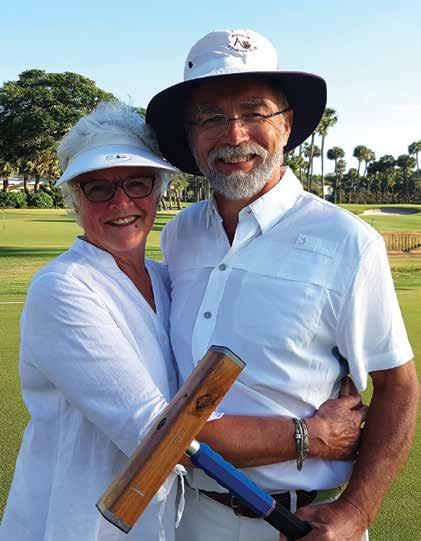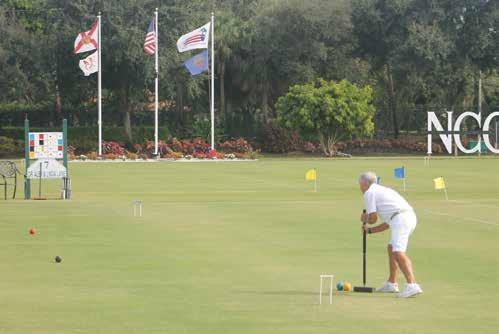
6 minute read
Member Profile: Don Oakley
Don Oakley
Age: 62
Home base: Brighton, Ontario, Canada
Home club: Brighton Lawnbowling & Croquet Club
Grip: Standard; Mallet (manufacturer, head size/weight, shaft length):; Oakley Woods Croquet Predator 38-1/2” tall, 11” head, 2lb - 9oz, straight shaft
Years playing croquet: 27 years
Can you tell us about Oakley Woods and how you got started in the mallet business? In 1991, a friend asked me to replace some tired, old backyard mallets. Building them from plans in a woodworking magazine, I had no idea of this ‘other world’ of croquet outside the backyard. The mallets attracted the attention of a couple of local croquet players who commissioned me to make two ‘tournament’ mallets. As a result of making those mallets, I met Bill Langstroth, founding president of Croquet Canada. It was with his help that I developed our Brighton mallet. From that modest beginning, people began asking for balls, hoops, clips and other related items. I started spending more time at tournaments, meeting more players and listening to what they wanted in mallets. The increased mallet sales quickly lead to hiring extra help. Over the next 25 years of customer feedback, product development and circumstance lead to the full range of croquet equipment we have now. With many of the top players in America using our mallets, I couldn’t have imagined then what our team is doing today at Oakley Woods Croquet.
What is the key to a top-quality mallet? The first thing is to get the height, weight and head length right for each player. Higher performance comes from using the right combination of materials to ensure the weight is in the right place in the mallet. For the most part, mallets should be weighted peripherally, that is, mostly toward their striking face. Shaft rigidity is also a very personal choice. While some like more flex, others (like myself) lean toward a more rigid handle. The use of carbon fiber in the handle has allowed us the ability to provide that choice. A further benefit is a lower center of gravity.
What is your key challenge in dealing with croquet customers? I thrive on feedback. Communication is critical to know what we’re doing right and where we can improve. Sometimes I’ve discovered a player is no longer using our mallet. It’s important to learn why. Often, we could have fixed the problem, like swapping out the handle for one with the right height or rigidity. If a player decides on another mallet maker’s design, I like to know what drew them to it. Although it’s easier to work with the player on the court to fit them properly, the process can be talked through by phone as well. It just takes a bit more time to get it right.
Favorite part about working with croquet players? There is a wonderful satisfaction in seeing the looks on players’ faces when we put the right mallet in their hands. They surprise themselves by making improved shots. I love teaching new players and watching their reactions when they successfully execute new techniques or strategies.
Favorite croquet venue: My wife Diana and I have been visiting croquet clubs for more than 20 years, providing mallets, teaching and “spreading the word.” High on my list are the many retirement communities we visit. There is an enthusiasm for the sport that seems to permeate through their residents. As for a favorite venue, we have been to too many clubs to single out one. They all have their inherit and unique beauty, whether it’s a mountain vista, ocean front view or a comfortable clubhouse setting for après-croquet.
Favorite tournament: This one ends up in a tie for favorite. The Bayfield Croquet Club and the Audubon Club host great tournaments. At both, I valued the well-oiled tournament organizing (Audubon’s by the late Fred Jones), camaraderie of the players, the food and the post-game activities. Many other tournaments are still on my bucket list that come with high recommendations from fellow players. If only my day job didn’t get in the way.
How did you get into the game? In 1992, Croquet Canada’s founding president, Bill Langstroth, encouraged me to make the trip to Palm Beach Gardens for the 1993 Club Teams. While there, Langstroth and then president of Croquet Canada, Dave Lewis, convinced me that I needed to play to lend credibility to my mallet-making skills. Langstroth provided a solid hour of instruction a week before the event. Lewis helped to secure a place in ‘C’ Flight. I was bitten by the croquet bug after the first game and have loved playing ever since. Over the years, I’ve played American 6-Wicket, Association Rules, Golf Croquet, 9-Wicket (backyard), Ricochet and other variations.
Croquet Highlights/Tourney Wins? In 2011, Diana and I traveled to Mission Hills, Calif., to play in the US Nationals. It was our first ever trip to California. Along with playing, we re-kindled old friendships, built new ones and tacked on a week of hiking the beautiful surrounding mountains. In 2016, we hiked and kayaked in New Zealand. There, we were surprised to see croquet clubs in almost every small town. With the help of new friends, Jenny and Chris Clarke in Christchurch, I took in some play. It seems that wherever we travel, croquet is the best way to connect with people. I find croquet players are a friendly and easygoing lot.
Do you play other sports? I am very passionate about my paddling sports. Diana and I have been wilderness paddlers for more than 40 years. It doesn’t matter if it’s canoeing or sea kayaking, just to be on the water and in the wilderness, brings an inner peace. I’ve also been a motorcyclist since I bought my first bike at 15.
Favorite sports teams: I can’t say I have a favorite sports team. Watching professional sports isn’t on my “preferred list” of things to do. That said, I have been known to get caught up in the playoff fever around just about any sport.
Pop culture favorites: A small but helpful book is “Golf is not a game of perfect.” Although it is written as a golf psychology book, its teachings can be directly applied to croquet.

What is the best thing the USCA has done for croquet? The organization has brought the sport to many players around the country. It is also responsible for teaching croquet skills to thousands of players who then go back to their home clubs to share their enthusiasm. The USCA has also brought the international world of croquet (WCF, Golf Croquet, Association Croquet) to America. This has added a great diversity to our sport and shown that we can compete on the international stage.
What is the USCA’s greatest weakness? We could do much more in marketing toward golf clubs, hotels, retirement communities, schools and backyard players. I don’t feel we make enough strategic use of mass media and social media in promoting our events and the results of our titled events.
What would you like to see happen in the sport over the next 10 years? I’d love to see our sport televised on news and sports reporting, highlighting some major events. If poker can be made interesting enough to televise, then why not croquet?
What have you learned from croquet? Patience, slow and steady, focus, keep your head down, swing smoothly and follow through. Focus, keep your head down, swing smoothly and follow through. Along with that, take some lessons from a professional.

Closing remark: Croquet is a sport run through the volunteerism of many. While serving on the boards of Croquet Canada and the USCA, I’ve seen many enthusiastic players give freely of their time. It is important that we take the opportunity to give back to a sport that gives us so much.








